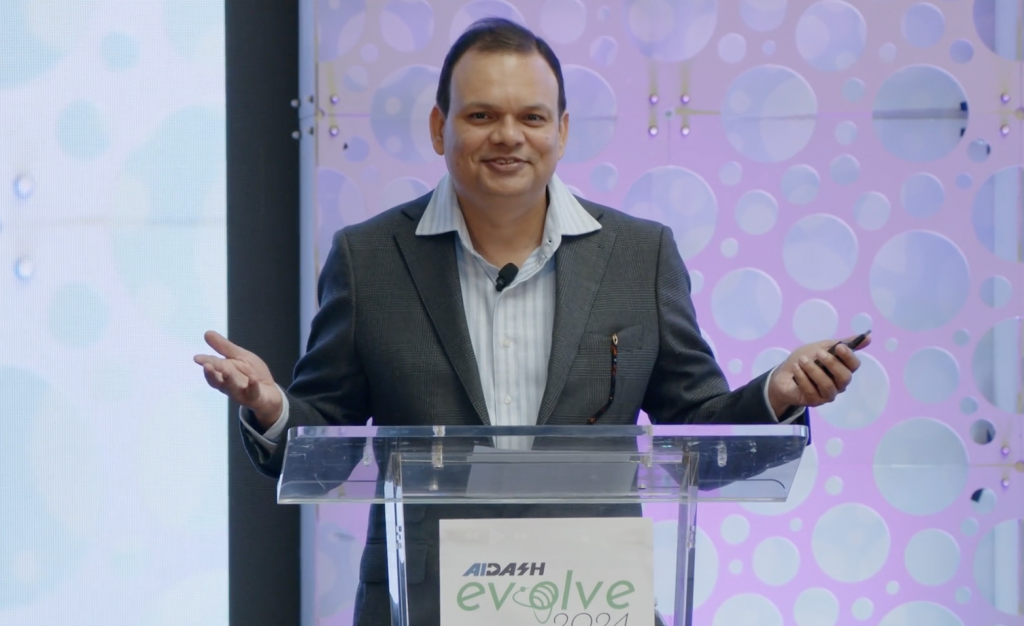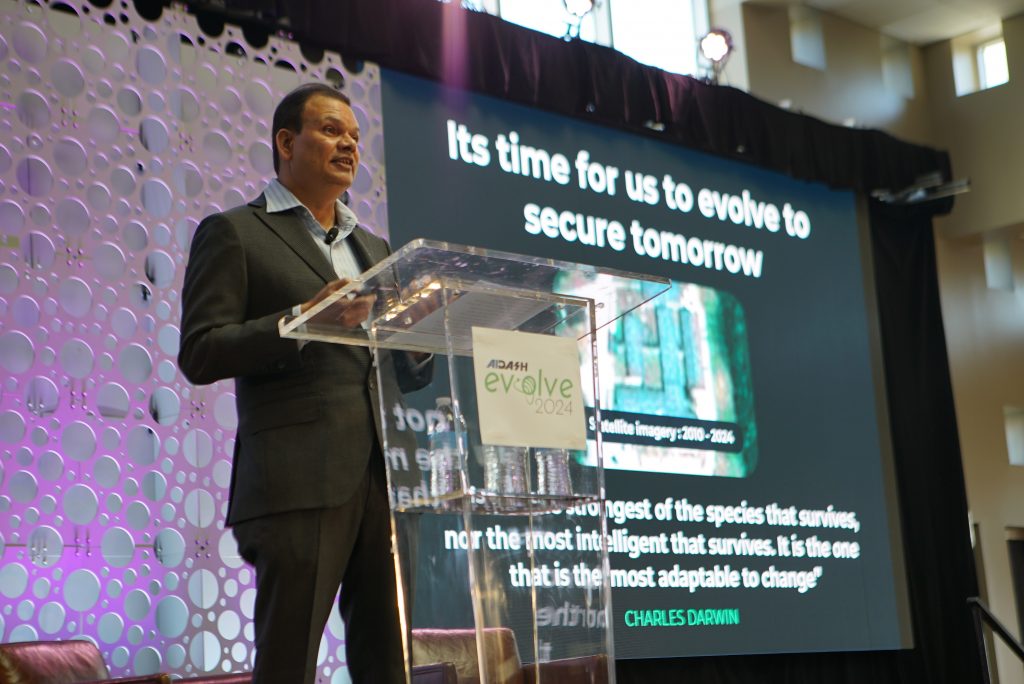Evolve 2024 welcome address: Abhishek Vinod Singh, Co-Founder and CEO, AiDASH

This is a recap of a session from AiDASH Evolve 2024.
Summary:
- AiDASH uses technology to help utilities address climate threats and secure the grid.
- We have to break down silos to meet the challenge of grid inspection and monitoring.
- Securing tomorrow together requires the work and dedication of everyone connected to the utility industry.
“When I wanted to welcome you to New Orleans, I did not want to welcome you to a New Orleans [that] is dark. I wanted…to welcome you to a bright New Orleans.” That’s how Abhishek Vinod Singh, Co-Founder and CEO, AiDASH, began his welcome address at AiDASH Evolve 2024.
Standing in front of a huge screen that showed a photo of New Orleans on an overcast afternoon with no power, Singh explained: The darkness is an important part of the city’s history.
Singh was born in a small village in India. When he was young, the village did not have electricity. Eventually, though, power arrived. “The first time when the power came to our village, and I pressed that switch…and it lit up a bulb…it was magic,” he said.
It was as magical, he said, as a fully lit New Orleans street in the evening.
“In our journey to build AiDASH in the last five years, we realized how difficult it is to get the lights on,” he said. It requires the ongoing dedication of everyone in the utility industry—not just to get the lights on, but to keep them on, and restore them quickly when there are outages.
But that’s becoming even more difficult as climate challenges increase. To keep the lights on, we all need to work together. “The utility representatives, the regulatory bodies, the government, the tech companies like us, the consultants, the data providers—everyone has to work together to secure critical infrastructure and foster biodiversity, and help us in securing tomorrow,” he said.
Solving grid reliability, inspection, and monitoring with technology
Singh talked about co-founding AiDASH in 2019 and why the company created software aimed at improving vegetation management. “Vegetation management was the single largest O&M spend,” said Singh, “and it deserved to have a software category of its own.”
That’s why AiDASH created its first product, Intelligent Vegetation Management System™ (IVMS).
AiDASH products solve the pressing needs of grid safety and reliability—affordably—and foster biodiversity. IVMS was but the first. Now, AiDASH’s product portfolio includes:
Intelligent Vegetation Management System™ (IVMS)
• More than 1 million miles of T&D lines monitored.
• 5-20% lower vegetation management expenses.
• 10-20% better grid reliability.
• More than 3 million miles of T&D lines processed by AiDASH’s AI engine.
Climate Risk Intelligence System™ (CRIS)
• 30% faster restoration.
• 25% lower storm costs.
• 85% accuracy forecasting outages.
• 15% fewer power outages during storms.
• 72 hours advance predictions for storm risks.
• 3-7 days wildfire risk and spread forecasts.
• Increased infrastructure resilience to wildfire events.
• Meet compliance standards.
Asset Inspection & Monitoring System™ (AIMS)
• 30-70% reduction in asset conflation time and costs.
• 2x faster asset inspection.
Biodiversity Net Gain Artificial Intelligence™ (BNGAI)
• Fast, automated, and easy.
• Accurate site biodiversity analysis.
• Meets high compliance standards.
Grid inspection and monitoring: A massive challenge
Grid inspection and monitoring is a massive challenge, and a company like AiDASH can’t solve it alone.
But, Singh said, “While the challenge is massive, it’s easy to understand.” He cited striking statistics on the U.S. power grid:
• 7 million miles of power lines.
• More than 200 million poles.
• More than 1 billion devices/assets.
• Billions of trees.
The assets and trees need to be inspected, the problems we find need to be mitigated, and the subsequent work has to be audited.
There are many point solutions available today to address these issues, but Singh said that too much grid maintenance today is done in silos, with point solutions, including those from AiDASH. It can be difficult for utilities to know which ones to use. That’s a problem AiDASH aims to solve.
“It’s time for us to evolve,” said Singh. He pointed to the way satellite image quality has evolved over the past 14 years, such that 20 cm resolution is available, providing unprecedented detail. “As humans have evolved, as AI has evolved, we need the grid monitoring and inspection technologies to evolve,” he said.
In response, AiDASH is building a unified approach to grid inspection and monitoring. It’s a satellite-first approach whereby AiDASH surveys a utility’s entire network once, and then again at any desired frequency. This approach uses a combination of satellites, aerial, LiDAR, vehicle-mounted cameras, and drones to capture every part of a network—including those areas that are inaccessible by four-wheeled vehicles.
“Once we have inspected, we can solve all use cases for asset inspection and monitoring,” said Singh. Because AiDASH uses multiple technologies, the company can go beyond just vegetation, and it costs less than using drones and LiDAR individually

AiDASH identifies challenges so utilities can mitigate what they need to, using whatever business constraints they have. For example, perhaps they need to focus their resources on just 2,000 of their most critical line miles.
Then when the work is done, utilities can use a field app and central dashboard—from AiDASH or another tool—to audit that work and complete the loop.
Securing tomorrow together
Singh said we need to unify grid-monitoring technologies with grid management technologies, like ADMS, OMS, and GIS, and that this task requires a great deal of cooperation between partners. “This is something [that] cannot be achieved by one company, or a few companies, alone. This requires a much larger team,” he said.
In that spirit, he thanked the sponsors—Maxar, Schneider Electric, UP42, and BCG—as well as the dozens of partners and all the utilities who are working with AiDASH and gathered at Evolve.
Singh concluded his welcome remarks by saying, “The future of humanity and the future of AI has merged. Now, AI is an important part of our life, and more importantly, AI consumes more energy, more electric power than human beings.”
“To secure tomorrow, to have a resilient grid, [and] to ensure energy transition, we need to secure the future of ‘humanAIty.’ We have to work together and safeguard our critical infrastructure.”
Check out more sessions and information from Evolve 2024, and reach out to see the AiDASH Platform in action!
The best collection of tools, tips, guides, and industry stories – straight to your inbox.
Subscribe to our newsletter
